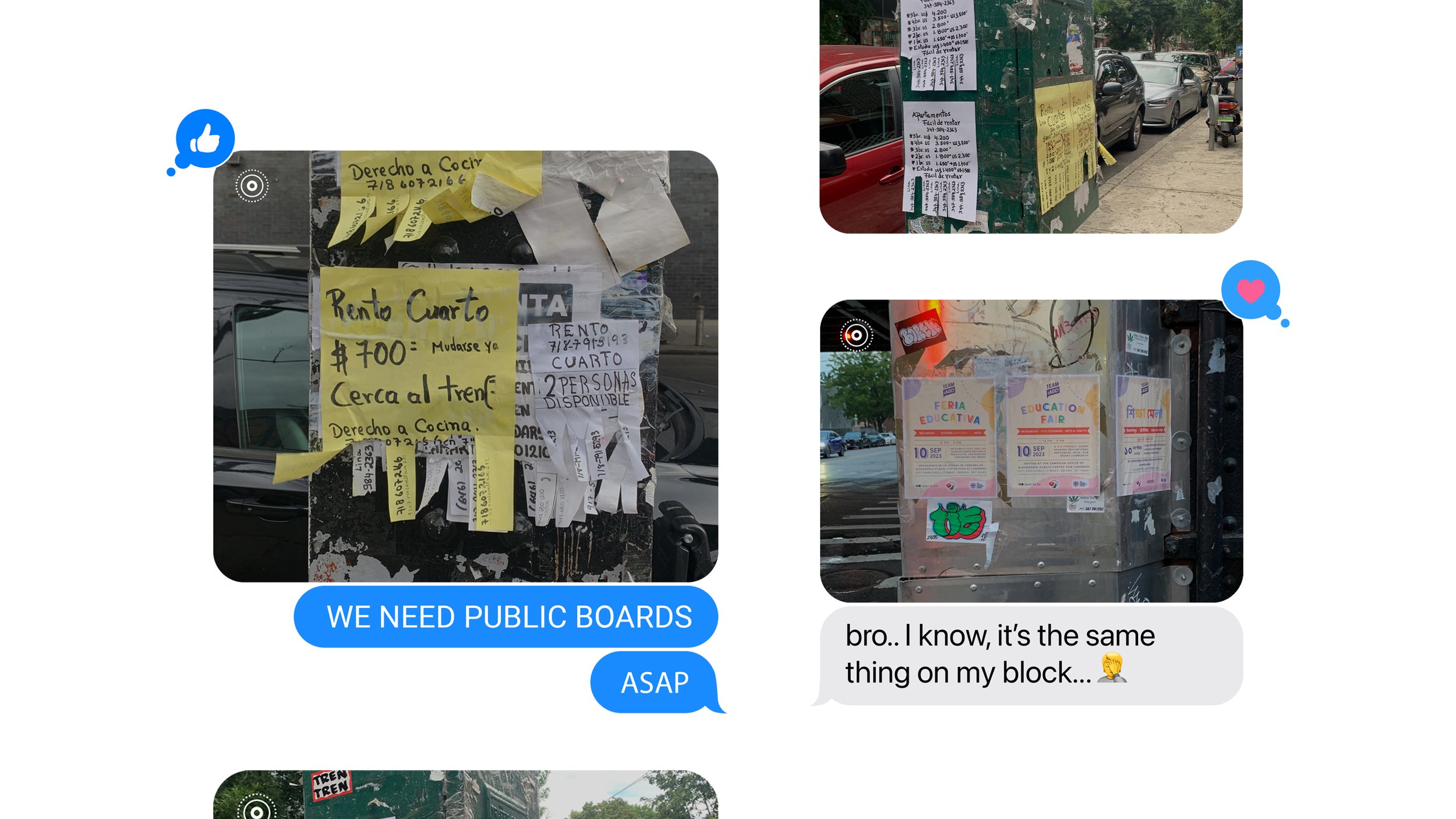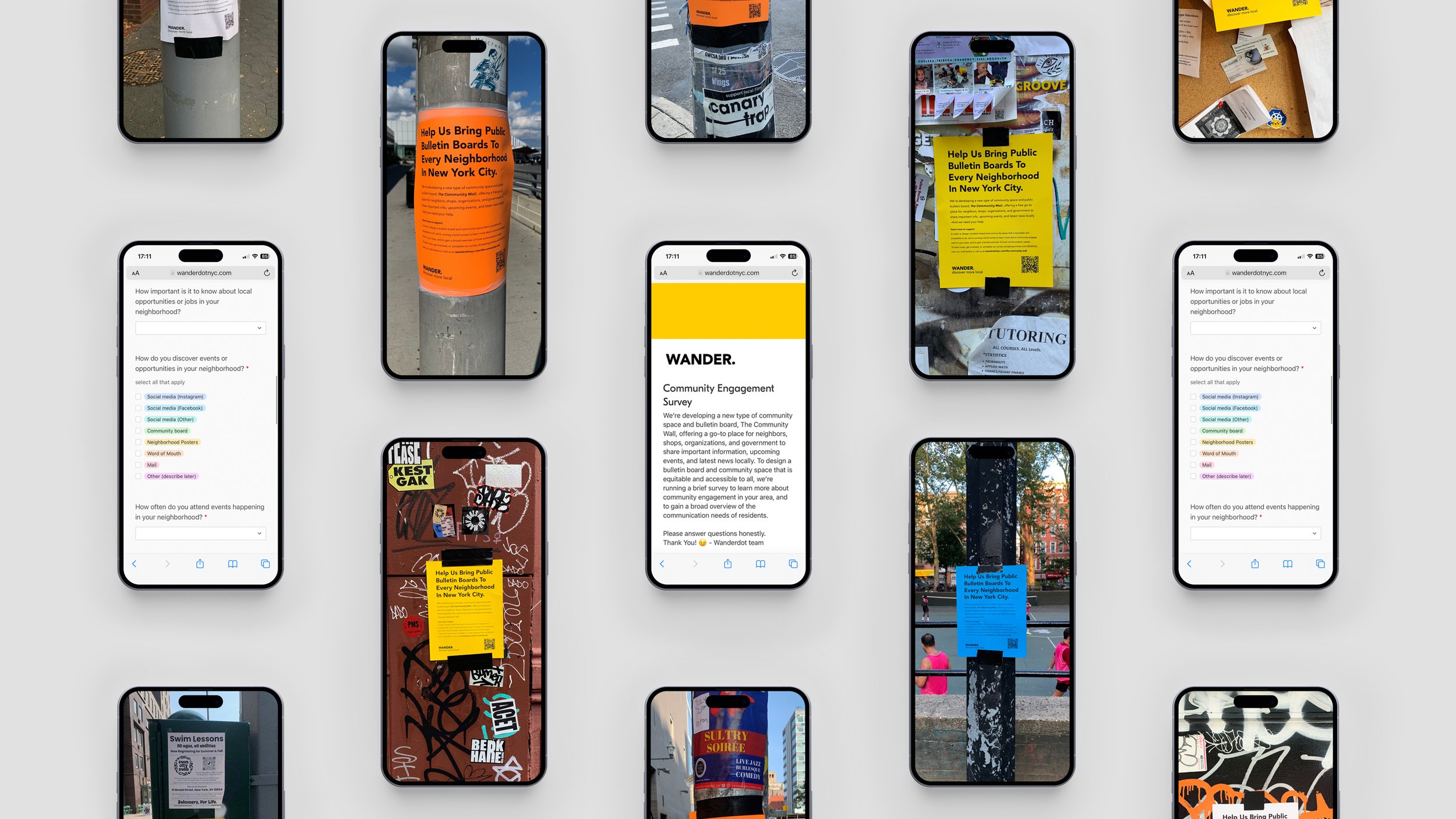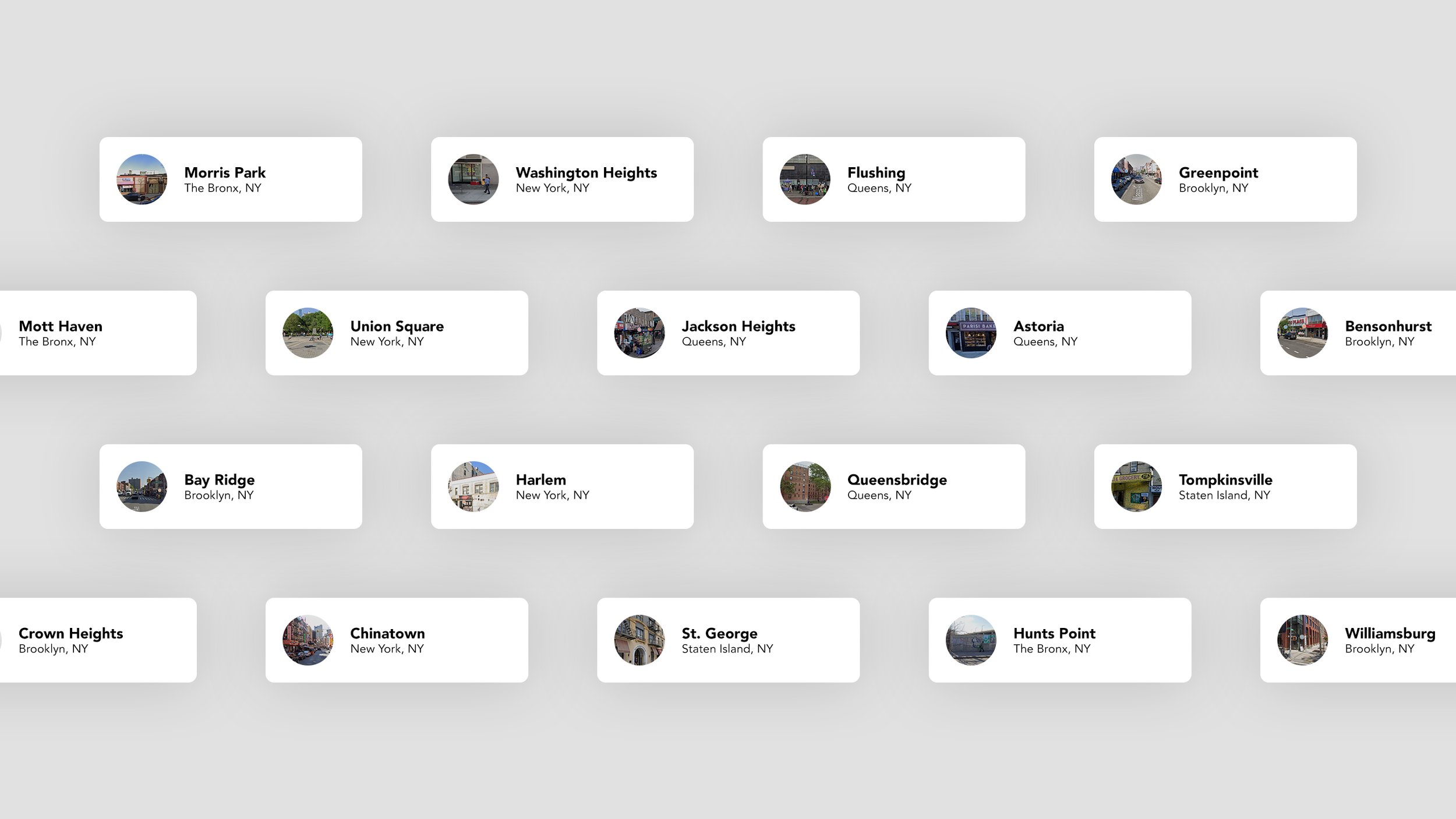We Want To Bring The Community Wall, A Public Bulletin Board Space, To Communities in need.
The Community Wall would offer an accessible place for neighbors, small shops, organizations, and government to share important information, upcoming events, and latest news locally.
MISSION
A major problem that exists in communities across the United States is the lack of information hubs and spaces for neighbors to share news or things happening locally with each other. This problem impacts low-income neighborhoods the most. As a result, many residents are left disconnected and disengaged from the things happening in their community which lessens the quality of life in those areas. In many cases, locals rely on social media or other online sources for information, which can be fragmented, unreliable, and inaccessible. Therefore, we’re developing a public tool (a third place and community bulletin board) that will help to promote local engagement and build a stronger sense of connection among neighbors–We call it The Community Wall.

VISION
A dynamic public design project set to transform how we share information and connect across the United States. The Community Wall is a public bulletin-board space intended to live on prominent, accessible, front-facing walls, serving as vibrant hubs for community engagement. For example, parents could visit The Community Wall at a New York City neighborhood to find activities and programs for their kids or share a flyer for an upcoming meetup among neighbors. It’s also a space where local government, community organizers, and law enforcement can make a call to action or share urgent information. But it's more than a bulletin board on a wall. These spaces are meeting points for locals, visitors, and the public, a way to stay informed about things happening in their area, and a network connecting all. We envision a space open to all in communities where anyone can seek and share information locally.

RESEARCH
From July to August 2023, we ran a 6-week survey to learn more about community engagement in NYC neighborhoods and to gain a broad overview of the communication needs of residents. Our survey asked residents to describe how they discover events and opportunities in their community and overall to rate communication in their area. We marketed the survey online through Instagram and LinkedIn and emailed information along with surveys to every community board, assembly member, and BID in NYC. Besides our digital efforts, we posted physical flyers with information about our study in visible areas and popular neighborhoods in each borough.
Our survey concluded with 440 participants; most were between the ages of 25-34. Although we distributed surveys to every borough in the city, most participants were in The Bronx (200). Brooklyn (130) received the second most participants, and then Manhattan (70). Queens (20) and Staten Island (20) saw the same number of participants. Of those who completed the survey, the majority identified as BIPOC (250) and or a member of the LGBTQIA+ community (120). Most surveyed were also not students, business owners, or directors of a community organization.
FINDINGS
Our survey revealed that most participants rated communication in their neighborhood as either moderate or inefficient. We asked participants about the frequency of finding opportunities or events in their community and found that participants only occasionally (260) found opportunities posted in their community. Most reported discovering local events through word-of-mouth and Instagram. We followed up on this question by asking participants to rate the effectiveness of the social accounts they received information from. Most participants rated the accounts they followed 3 out of 5 stars or moderately helpful. Below are statistics on some of the other questions asked.
How would you rate overall communication in your area? (from 1 to 5 stars)
How important is it (to you) to know about things happening in your neighborhood?
We also provided participants with a space to share thoughts or comments on communication in their area:
“The only community information I receive is crimes in the area from Citizens App. Never good news.”
“I would like to see an established venue for town halls with elected officials.”
“Heaviest flyering is from non-transparent corporate interests on behalf of the community, especially around safety. Need accessible boards for community members to post, not corporations.”

PILOT DESIGN
Working with the community, we sought to design, develop, and launch a 1-year pilot in 2024 to test strengths, weaknesses, and opportunities for growth of these public bulletin board spaces that are The Community Wall. In three phases, we hoped to measure local engagement, connectedness, and whether or not The Community Wall would work for neighborhoods in NYC.
We hoped to measure this through regular check-ins with community partners, direct observation, behavior mapping, and stakeholder meetings on and offline. We planned to hire local stewards in every participating neighborhood to help oversee this. As ambassadors to the community, stewards would’ve helped to oversee the Community Wall in their neighborhood, ensuring accessibility for all, and gathering feedback.
To minimize bias in our pilot, we wanted to launch in at least three distinct types of neighborhoods in each borough. This would’ve helped us to test how The Community Wall performs in (1) changing, (2) tight-knit, and (3) heavily populated areas.
-
The pilot was intended to kick off with the launch and installation of 5 Community Wall spaces throughout the city. After launch, our primary focus for the remainder of the phase would’ve been on community engagement and onboarding local stakeholders. Besides installing physical boards in selected neighborhoods, we also planned to host several workshops and demonstrations to encourage community participation.
-
To expand on the work started in phase one by launching a Community Wall in 5 additional neighborhoods and making any necessary adjustments to those previously installed. In this phase, volunteers would assist our local stewards in monitoring stakeholder engagement through regular check-ins, surveys, and focus group meetings. Our team would also document progress and conduct a mid-pilot evaluation in this phase to assess whether or not we’re meeting our pilot objectives.
-
Launching in 5 additional neighborhoods. A lot of the work in this phase would’ve focused on evaluating our project and whether or not this pilot has made a case for The Community Wall in NYC. Hosting several meetings throughout our network to hear final thoughts from the community and working closely with our team to generate a report with lessons learned. This phase is crucial in our pilot because it would’ve helped us to determine whether or not the project would continue on much after the end of our pilot.

ESTIMATED COSTS
We estimated that it would cost at least $600K to launch our pilot for The Community Wall. Our costs would’ve included the following:
-
The construction and mounting of each bulletin board, materials needed for beautifying the space where the boards will be mounted
-
Consultant fees for legal advice, liability insurance, permits, and licenses
-
Stipends for local stewards, advertising the project to stakeholders, incentivizing participation in quarterly interviews and focus groups
-
Project manager and consultant fees
-
Funds set aside for unexpected expenses or in case there are changes to the project scope.
We estimated that our 1-year pilot would’ve cost approx. $40K per neighborhood to implement.
COST BREAKDOWN PER NEIGHBORHOOD
FUTURE DEVELOPMENT
Although we were unable to secure funding in 2024 to help us get this project off the ground, our work is far from over. Understanding that this is a huge undertaking, we are taking a brief pause to re-energize, re-strategize, and plan for a better approach in the future. Please stay tuned for more or reach out to help support this project.



